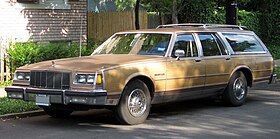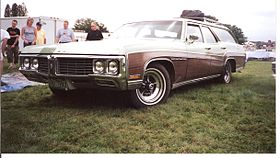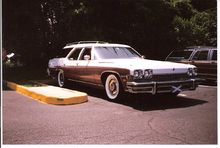Buick Estate
| Buick Estate Wagon | |
|---|---|
 Third generation version | |
| Overview | |
| Manufacturer | Buick (General Motors) |
| Also called | Buick Electra Estate Buick LeSabre Estate |
| Production | 1970–1990 |
| Body and chassis | |
| Class | Full-size car |
| Body style | 4-door station wagon |
| Layout | FR layout |
| Related | Oldsmobile Custom Cruiser |
The Buick Estate was a line of full-sized station wagons manufactured by the Buick division of General Motors. As its premier luxury division, Cadillac, didn't offer a station wagon, the Estate was GM's most expensive and most fully equipped entry in the market.
Early history
The first Buick Estate station wagon was a large-bodied GM C platform Super modified with a wooden body, shared with the Oldsmobile Series 60. In 1941 and 1942 it was available on Buick's B platform Special series, and later on Buick's C platform (Roadmaster and Super) in the 1946–53 model years. From 1954 to 1958 it was only offered on the smaller B platform Century and Special, with all steel bodies. Among these were hardtop Estate Wagons called Caballero that were offered only in 1957 and 1958.
From 1959 through 1964 the Estate Wagon was offered on the B platform Invicta and LeSabre. In 1965, the Estate Wagon was replaced by the new, smaller A platform Buick Sport Wagon, making the B-body Chevrolet Impala Estate and Pontiac Safari the only full-sized GM station wagons until 1970.
1940s
-
1941 Buick Special Estate (Model 49)
-
1942 Buick Special Estate (Model 49)
1950s
-
1950 Buick Roadmaster Estate
-
1952 Buick Super Estate
-
1953 Buick Super Estate, last of the genuine "woodies"
-
1955 Buick Special Estate
-
1956 Buick Special Estate
-
1958 Buick Century Caballero Estate hardtop
1960s
-
1964 Buick LeSabre Estate
-
1966 Buick Skylark Sport Wagon
-
1967 Buick Skylark Sport Wagon Custom
-
1969 Buick Skylark Sport Wagon
1970
| First generation | |
|---|---|
 | |
| Overview | |
| Model years | 1970 |
| Assembly | Flint, Michigan, United States |
| Designer | Bill Mitchell |
| Body and chassis | |
| Platform | B-body |
| Related | Buick Wildcat Buick LeSabre Oldsmobile 88 Pontiac Bonneville Pontiac Executive Pontiac Catalina Chevrolet Caprice Chevrolet Impala Chevrolet Bel Air Chevrolet Biscayne |
| Powertrain | |
| Engine | 455 cu in (7.5 L) Buick V8 |
| Transmission | 3-speed TH-400, automatic |
| Dimensions | |
| Wheelbase | 124.0 in (3,150 mm) |
| Length | 220.2 in (5,593 mm) |
| Curb weight | 4,900–5,000 lb (2,200–2,300 kg) |
The Buick Estate wagon was re-introduced as the top-level luxury station wagon for GM in 1970 to compete against the Mercury Colony Park and Chrysler Town & Country. Buick's first full-sized station wagon since 1964, it was available as a separate series on the B-body LeSabre and Wildcat, sharing their 124.0-inch (3,150 mm) wheelbase, basic body and interior. The LeSabre Custom's bright rocker, wheelhouse and rear lower fender moldings were used. Woodgrain was an option for the body sides, incorporating the traditional "Sweepspear" feature. Interiors were all vinyl in a Custom grade. Despite being on the B-body it shared the C-body division flagship Electra's 455 cubic inch V8 and four VentiPorts on the front fenders. The following year the Estate would move up to Electra's larger body and more voluminous interior.
1971–1976
| Second generation | |
|---|---|
 1971 Buick Estate Wagon | |
| Overview | |
| Production | September 1970-August 1976 |
| Model years | 1971–1976 |
| Assembly | Flint, Michigan, United States |
| Designer | Bill Mitchell |
| Body and chassis | |
| Platform | C-body |
| Related | Buick Electra Oldsmobile 98 Oldsmobile Custom Cruiser Pontiac Grand Safari Pontiac Safari Chevrolet Kingswood Estate Chevrolet Kingswood Chevrolet Townsman |
| Powertrain | |
| Engine | 455 cu in (7.5 L) Buick V8 |
| Transmission | 3-speed TH-400, automatic |
| Dimensions | |
| Wheelbase | 127.0 in (3,226 mm) |
| Length | 1971: 226.8 in (5,761 mm) 1972: 228.3 in (5,799 mm) 1973: 229.5 in (5,829 mm) 1974: 231.1 in (5,870 mm) 1975–76: 231.8 in (5,888 mm) |
| Width | 1971–72: 79.7 in (2,024 mm) 1973: 79.6 in (2,022 mm) 1974–76: 79.9 in (2,029 mm) |
| Height | 1971–1973: 57.3 in (1,455 mm) 1974: 57.9 in (1,471 mm) 1975: 58.4 in (1,483 mm) 1976: 57.8 in (1,468 mm) |
| Curb weight | 5,100–5,400 lb (2,300–2,400 kg) |
The 1971 to 1976 Estates were the first Buick station wagons to be built on its largest chassis since the Roadmaster Estates of 1947–53. However, even though the Estate shared its 127.0-inch (3,230 mm) C-body wheelbase with the Electra 225, all 1971–76 GM wagons were assigned B-body-based per model numbers.[1] The 1971–76 GM full-size bodies, at 64.3-inch (1,630 mm) front shoulder room and 63.4-inch (1,610 mm) rear shoulder room set a record for interior width that would not be matched by any car until the full-size GM rear-wheel drive models of the early to mid 1990s. The Estate also shared the Electra 225's interior and exterior styling from 1971 to 1974 (complete with the prerequisite four VentiPorts). Door trim and seats were not as plush in 1971–74 wagons and no door pull strap was included as it was on the Electra.
Although from 1975 to 1976 the number of VentiPorts were reduced by one, and the front fascia was downgraded to a LeSabre's (as was door trim and seats), the Electra 225 style chrome rocker panel moldings and distinctive Electra 225 style rear quarter panels (albeit without fender skirts) remained. The taillights were different from both the LeSabre and the Electra in all of these years. The Estate Wagons, as with other GM full-sized wagons during these years, used a rear suspension with multi-leaf springs instead of the coil springs used on other full-sized Buicks, and other full-sized GM cars.
The Estate Wagons also featured a new 'clamshell' tailgate design, marketed as the Glide-away Tailgate, where the rear power-operated glass slid up into the roof as the lower tailgate (manually or with power assist), slid into a recess under the cargo floor. Ultimately, the manual lower tailgate was supplanted by the power tailgate. The tailgate system was operated by switches on the instrument panel or a key switch on the rear quarter panel. Like a top-hinged tailgate, the clamshell design allowed a user to stand directly at the open cargo area without impediment, facilitating loading and unloading in tight spaces. the rear seat could be folded flat for additional cargo, and incorporated a 60/40 split so that extended cargo and passengers could be accommodated.

In its first year, 24,034 Estate Wagons were sold.[2]
At 5,182 lb (2,351 kg) shipping weight, or about 5,400 lb (2,400 kg) curb weight, the three-seat 1974 Estate Wagons are easily the heaviest Buicks ever built, even heavier than the Buick Limited limousines of 1936–42. The 1975 and 1976 models were the longest station wagons ever built.[3]
The Estate used the Buick 455 from 1971 to 1976 throughout. The last year that the Stage One high performance version, with high lift camshaft, enlarged ports, enlarged valves and dual exhaust was available was in 1974.
1977–1990
| Third generation | |
|---|---|
 | |
| Overview | |
| Model years | 1977–1990 |
| Assembly |
|
| Body and chassis | |
| Platform | B-body |
| Related | Buick Electra Buick LeSabre Oldsmobile 88 Oldsmobile Custom Cruiser Pontiac Bonneville Pontiac Parisienne Pontiac Catalina Pontiac Safari Chevrolet Caprice |
| Powertrain | |
| Engine | 350 in³ Buick V8 307 in³ Oldsmobile V8 350 in³ LF9 diesel V8 |
| Transmission | 4-speed automatic |
| Dimensions | |
| Wheelbase | 115.9 in (2,944 mm) |
| Length | 220.5 in (5,601 mm) |
| Width | 79.3 in (2,014 mm) |
| Height | 59.3 in (1,506 mm) |
In 1977, the Buick Estate was downsized and relaunched on General Motors' B-body. In 1979, an Estate Wagon Limited was offered with many extra cost options included as standard. To further differentiate the Limited model, fenders included four VentiPorts (up from three) and the interior had loose pillow designed seating. In 1980, body changes made the wagon more aerodynamic for better fuel efficiency. Also that year, the Electra Estate Wagon was introduced and replaced the Estate Wagon Limited while the 'base' model was now called the LeSabre Estate Wagon. The Buick 350 V8 engine was dropped from the options list because 1980 was the final year of production for that engine. The standard engine now was the 5.0 Oldsmobile 307 engine.

According to The Buick Book, 1987. In 1987 Buick offered Electra Estate Wagon (V35) and LeSabre Estate Wagon (R35). Both wagons are equipped with the 5.0 litre 4 bbl V8. The Electra Estate Wagon was to be the more luxurious of the two models. Buick also offered a 29.5 inch shorter and 9.9 inch smaller front wheel drive Century Custom Wagon (H35) and Century Estate Wagon (L35). Three choices of engines was offered. A 2.5 litre Tech IV with Electronic fuel injection, a 2.8 litre V6 with Multi-port fuel injection and a 3.8 litre V6 with Sequential-port fuel injection. The Century Custom Wagon was aimed towards "the active living and hard-working utility" and the Century Estate Wagon towards "luxury touches by the score". Both models of the Century Wagon could be equipped with an optional third seat; "Surprisingly perhaps, eight full-size adults can seat themselves in the contemporary-sized Century Wagon".

Although the Electra and LeSabre coupes and sedans had both switched to new front wheel drive platforms by 1986, the model names also continued to be used on the rear wheel drive wagons through 1989. In 1990, its final year, the Electra and LeSabre model designations were dropped and the car was once again sold simply as the Estate Wagon. Although the Estate Wagon model was discontinued in 1990, the Estate trim designation continued on the mid-size Century and full-size Roadmaster station wagons through 1996.
1991–1996

Buick revived the Roadmaster name with the introduction of the Roadmaster Estate in 1991. A "Vista Roof" fixed sunroof over the second row seats, was standard. Initially the Roadmaster Estate used Chevrolet's 5.0 L L03 V8. It was replaced a year later with a 180hp 5.7L small-block L05 V8 shared by both wagon and sedan. In 1994 both received a modified dual-exhaust version of the advanced Corvette-derived 5.7L sequential point fuel-injection LT1 V8, increasing output to 260hp and upping performance substantially. The same engine was used on the Impala SS, Chevrolet police interceptors, and the Cadillac Fleetwood, with an aluminum head version on the Corvette C4, Camaro Z-28, and Firebird Trans-AM. A high-performance engine had last been offered on a GM station wagon in 1974.
GM discontinued the Roadmaster Estate in 1996, ending production on December 13 of that year.[4]
Notes
- ^ 1976 Buick sales brochure says wagon models are 4BR35 and 4BR45. One telltale is the lower inside door trim which was hard plastic in 1971–76 B-bodies and padded vinyl in C-bodies. Wheelbase is not a good indicator of body; check rear legroom.
- ^ Flory, J. "Kelly", Jr. American Cars 1960–1972 (Jefferson, NC: McFarland & Coy, 2004), p. 793.
- ^ "12. What was the biggest station wagon ever made?". FAQ's. Stationwagon.com. Retrieved 2013-10-07.
- ^ Ward's Automotive Yearbook 1997. Ward's Communications, Inc. 1997.
Sources
- Flory, J. "Kelly", Jr. American Cars 1960–1972. Jefferson, NC: McFarland & Coy, 2004.












